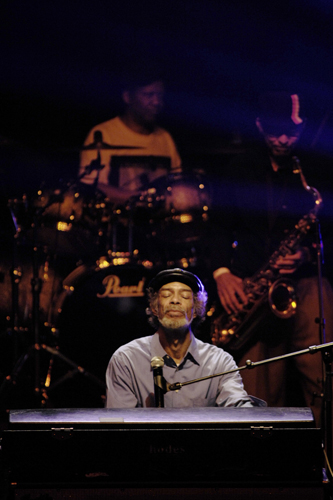The following is an excerpt from a 3 September 2014 email exchange between Art and Will.

"Gill Scott Heron 2009 Regency" by Adam Turner - Own work. Licensed under CC BY-SA 3.0 via Wikimedia Commons.
Art:

"Gill Scott Heron 2009 Regency" by Adam Turner - Own work. Licensed under CC BY-SA 3.0 via Wikimedia Commons.
Art:
I wanted to keep the dialogue/dialectic going as best we can, although I know you're likely to be busy this year. Respond when and if you can! I myself probably won't be able to continue recording until next weekend. Hopefully, I'll be able to send something along at that point.
Aside from the Garageband work, what chapter would need to happen next for you for the story to be coherent and/or edifying? If we had the time and resources, what era do you feel needs to be visited and why? What part of the story would be explored? What messages need to be conveyed before, as Kierkegaard puts it, "the event most opposite to his intentions should come to pass, and instead of setting the others in motion, the others acquire power over him, so that he ends by being bogged in the aesthetic."Will:
I don't know if this answers the question, but I'm reading How to Read Literature Like a Professor, and even though nothing in the book is new info to me, it does strike me that maybe we need to mine, as we did in the early days, the mythologies of Detroit music history a bit more. I use the term mythology broadly since we're really talking about history, but rock and roll always has that Byronic element of self-mythologizing. You wrote a particularly poignant message about Joe Catholic vs. Marvin Gaye or Gil Scott-Heron; maybe it makes sense to think of how we can comment on these geniuses who don't get their due through our story of Arthur. Maybe the same is true for mystics like Blake. There's a tendency to romanticize the story of talent that burns too brightly, but not much of an effort to examine it beyond the typical ways. It's so easy to shut down thought with clichés: he was too beautiful for this world, he lives on through his art--that sort of thing. And meanwhile, people turn to the greatest hits and don't even try to know the artist. There's some unfocused connection I'm drawing between these people who were wired to truth, beauty, and goodness in modes we can't comprehend (and that may even find expression in sinful ways) and the dawn of a new age of pillar saints.
I'm always struck by the connection between so many saints and prophets and performance art. I think of McLuhan's notions of the artist as being the only person who lives in his age and saints being the greatest artists as they always live in the eternal now and therefore are the most present in the demands of their age. I also think of his interpretations of gestalt theory and art as an anti-environment and the educational possibilities of anti-environments. Our project tries to draw people into anti-environments. And the pillar saint is all about the anti-environment. There we find ministry through anti-ministry: followers flock to their isolation, their alternative approaches, their inversion of normal secular priorities...even their inversion of traditional notions of the moral sphere of existence.
Thinking of all this, I'd say the part of Arthur (and Will) we have least developed is their end. We hint at what might happen to them, but we live in that postmodern age in which we can't view endings without skepticism and irony. You wrote a glorious ending for Farthington that resolves ironically to the St. Elsewhere finale kind of thing, but even if we followed that ending verbatim, Arthur still lives on afterward. Maybe the event ends a chapter but not the whole story. Or is that the Frankenstein-sort of ending in which the doomed outsider outlives his tormentors by a narrow margin (at least in his mind)? Or...
I'm struck by a story my sister told me. A student asked one of her profs if he was still capable of being shocked by an exhibit. He said yes--he would be shocked if he found something truly beautiful.
Is it possible to develop a truly beautiful ending?
What would it look like for an elderly Arthur to find a pillar in contemporary Detroit?
Even if it's a literal pillar in my mind for now, it's a striking image for the beginning and end of the story...something akin to the album cover of Rush's A Farewell to Kings.
But I don't want something as simple as Arthur amid ruin porn.
I doubt a pillar saint in Detroit would be noticed.
No comments:
Post a Comment